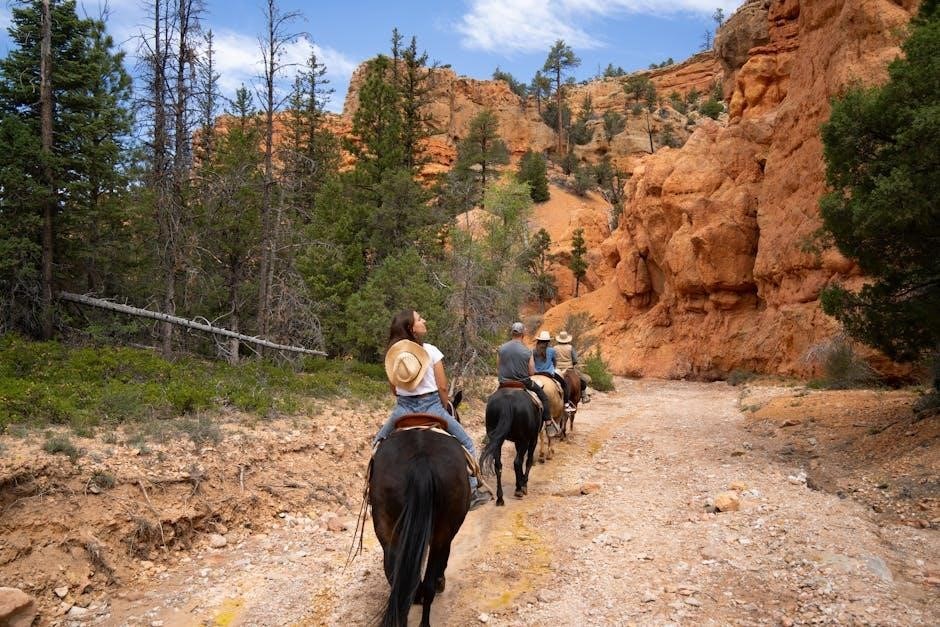Wilds of Eldraine Limited introduces a dynamic gameplay experience, blending new mechanics like Bargain and Roles with returning elements such as Adventures and Food Tokens. This set offers a fresh yet familiar environment for draft and sealed deck strategies, emphasizing token generation and synergistic plays. Whether you’re a seasoned pro or a newcomer, mastering these interactions is key to success in the Wilds of Eldraine Limited format.
1.1 Overview of the Set and Its Mechanics
The Wilds of Eldraine set is inspired by fairy tale aesthetics, blending enchanting creatures and magical themes. It introduces unique mechanics that shape the Limited format, offering a fresh gameplay experience. Key features include Adventures, which allow creatures to transform into powerful beings, and Food tokens, enabling resource generation. The set also explores Bargain, a mechanic rewarding players for casting spells with alternative costs. These elements create a dynamic environment where adaptability and strategy are crucial. Understanding these mechanics is essential for success in both Draft and Sealed formats, as they significantly influence deck-building and gameplay decisions.
1.2 Importance of Understanding the Limited Format
Understanding the Limited format is crucial for success in Wilds of Eldraine. This format demands a deep knowledge of the set’s mechanics, card synergies, and strategic nuances. Limited play emphasizes adaptability, as players must build decks from a random pool of cards. Mastery of draft and sealed deck strategies requires insights into card evaluation, archetype recognition, and resource management. Without a strong foundation in Limited principles, players risk misjudging card values and missing opportunities to capitalize on the set’s unique mechanics. This understanding is the cornerstone of competitive play and ensures players can maximize their deck’s potential in any scenario.

Core Mechanics in Wilds of Eldraine
Wilds of Eldraine introduces unique mechanics like Adventures, Food, Bargain, Roles, and Celebration, which redefine gameplay and strategy, offering depth and fresh opportunities for deck building and combat.
2.1 Adventures
Adventures are a groundbreaking mechanic in Wilds of Eldraine, allowing creatures to be exiled with a bonus effect and then returned to the battlefield with a permanent boost. This mechanic is central to the set, enabling flexible strategies that blend offense and defense. Timing the use of Adventures is crucial, as they can provide early-game tempo or late-game surprise value. Key creatures with Adventures often become high-value targets, making them pivotal in shaping deck archetypes and in-game decisions. Mastering Adventures is essential for leveraging their full potential and creating powerful synergies in Limited play.
2.2 Food Tokens
Foods Tokens are a unique mechanic in Wilds of Eldraine, representing edible resources that provide life gain when used. They are generated by specific cards and can be stored for later use, offering flexibility in gameplay. Food Tokens synergize well with life-gain strategies and can be critical in races or defensive scenarios. Managing Food Tokens effectively enhances deck resilience, allowing players to adapt to various game states. Their presence influences deck-building decisions, particularly in Golgari and Gruul archetypes, where life gain and resource management are key. Food Tokens add a layer of depth to the Limited format, rewarding strategic planning and efficient use of resources.
2.3 Bargain
Bargain is a dynamic mechanic in Wilds of Eldraine that allows players to cast spells for life instead of mana, up to a limit of three times per game. This mechanic opens opportunities for aggressive plays and enables players to cast high-impact spells earlier. However, it requires careful life management, as overuse can leave players vulnerable. Bargain synergizes well with low-toughness creatures and direct damage, making it a key tool in aggressive and combo-oriented decks. Properly leveraging Bargain can significantly enhance a deck’s power, but it demands strategic balance to avoid risking defeat through life loss.
2.4 Roles
Roles in Wilds of Eldraine are a unique mechanic that assigns specific functionalities to creatures, enhancing their versatility. Each creature with a Role gains additional abilities or keywords, making them more valuable in various strategies. For instance, a creature might serve as a blocker, a attacker, or provide utility like card draw. Roles synergize with other mechanics like Food and Adventures, allowing for dynamic gameplay. They enable players to adapt their creatures to different situations, making them pivotal in deck-building and strategy. Properly utilizing Roles can significantly enhance a deck’s flexibility and power, offering a rich layer of depth to the game.
2.5 Celebration
Celebration is a unique mechanic in Wilds of Eldraine that triggers when a player reduces their life total to exactly 1. This mechanic offers a variety of effects, such as drawing cards, creating tokens, or gaining life. Celebration is optional, allowing players to choose when to activate it. Cards with Celebration often provide powerful rewards, encouraging players to embrace risky strategies. This mechanic adds a layer of excitement and risk-reward dynamics, making life totals a strategic consideration. Properly timing Celebration can turn the tide of a game, making it a memorable and impactful part of the set.

Color Pairings and Archetypes

Wilds of Eldraine Limited features distinct color pairings, each offering unique mechanics and playstyles. Understanding these archetypes is crucial for success in Draft and Sealed formats.
3.1 Boros Aggro
Boros Aggro is a hyper-aggressive archetype focusing on dealing maximum damage early. It relies on low-toughness, high-power creatures like Inspiring Veteran and Fervent Champion, amplified by anthems and combat tricks. The archetype thrives on synergy between cheap, evasive threats and trample enablers. Key cards include Drawn to the Flame and Stolen by the Fae to disrupt opponents. Boros Aggro excels in aggressive metas but struggles against heavy removal or sweepers. Properly leveraging trample and first-strike effects is crucial for success. Pairing with Food or Adventure synergies can enhance its explosive potential.
3.2 Rakdos Rats
Rakdos Rats is a disruptive, aggressive archetype centered around cheap, evasive creatures and sacrifice synergies. It leverages deathtouch and low-toughness threats like Inquisitive Puppet and Charming Prince to chip away at opponents. The archetype thrives on sacrificing creatures with Ayara, First of Locthwain or Barge In to generate card advantage. Rakdos Rats excels at punishing slow starts but struggles against sweepers or heavy removal. Properly managing sacrifice outlets and baiting removal is key; The archetype’s strength lies in its ability to disrupt opponents while maintaining a steady stream of pressure.
3.3 Gruul Monsters
Gruul Monsters is a ramp-based archetype that leverages cheap mana acceleration to cast high-impact creatures early. Cards like Llanowar Elves and Beanstalk Giant enable explosive starts, allowing players to deploy threats like Marwyn, the Nurturer or Reknit. The archetype relies on overwhelming opponents with large creatures and anthems like Beastmaster’s Harvest. Gruul Monsters excels in games where it can establish a quick board presence, but it struggles against removal-heavy decks or those with sweepers. Properly timing ramp spells and protecting key threats is crucial for success with this aggressive, midrange-oriented strategy.
3.4 Golgari Food
Golgari Food is a midrange archetype centered around generating and utilizing Food tokens. Cards like Trail of Crumbs and Gilded Goose create Food, enabling ramp and card advantage. The archetype thrives on synergy, with cards like Moonlit Scavengers and Bake Into Pie amplifying Food’s value. Golgari Food excels at generating card advantage but struggles against heavy removal or board wipes. Managing Food production and protecting key payoff cards is essential. This archetype rewards players who balance early game setup with late-game payoff, making it a versatile and consistent choice in Wilds of Eldraine Limited.
3.5 Selesnya Roles
Selesnya Roles is a midrange archetype that leverages the Roles mechanic to create versatile creatures. Cards like Acclaimed Contender and Snubhorn Sentry shine by adapting to the board state. The archetype focuses on go-wide strategies, with token generators like Flowering Finder and Harvest Home fueling a strong board presence. Synergies with Food and Celebration enhance its consistency. Selesnya Roles excels at midrange battles but can struggle against heavy removal or flyers. Properly timing role activations and managing creature counts are key to success in this archetype.
3.6 Orzhov Midrange
Orzhov Midrange is a versatile archetype that combines black and white cards to create a balanced deck. It leverages high-toughness creatures like Charming Prince and Wicked Guardian, which excel in midrange battles. The archetype also benefits from Food synergies and Bargain activations, providing card advantage. Cards like Doom Foretold encourage trading, while Reaper of Night offers late-game value. Orzhov Midrange struggles against aggressive decks but shines in grindy matchups, making it a solid choice for players who prefer a mix of defense and offense. Properly managing Food and timing removal spells is crucial for success.
3.7 Dimir Faeries
Dimir Faeries is a tempo-oriented archetype leveraging blue and black cards. It features evasive creatures like Faerie Seer and Whispering Woods, which excel at swarming the board. Support cards like Coveted Prize enhance card quality by filtering draws, ensuring you find key spells. Additionally, Into the Story offers card draw, helping maintain tempo. The archetype thrives against midrange and control decks due to its ability to overwhelm them but struggles versus aggressive strategies that can race effectively. Players should focus on early aggression, preserving threats, and timing removal spells to clear the way. Properly utilizing Faerie synergies is crucial for success in this archetype.
3.8 Izzet Spells
Izzet Spells is a blue-red archetype centered around cheap, impactful spells and creatures that synergize with them. Cards like Into the Story and Brineborn highlight the deck’s ability to generate card advantage. The archetype excels at controlling the board with removal and counterspells while applying pressure with evasive creatures. Wandmaker and Spellgorger are standout performers, offering both offense and defense. Izzet Spells thrives in matchups where it can leverage its card quality and tempo, particularly against slower decks. However, it struggles against aggressive strategies that overwhelm its defensive capabilities. Balancing interaction and threats is key to success with this archetype.
3.9 Simic Ramp
Simic Ramp is a green-blue archetype that leverages mana acceleration to cast powerful spells ahead of schedule. Cards like Llanowar Elves and Leafkin Drummers enable early plays, while payoff cards like Hydroid Krasis and End-Raze Forerunners dominate the late game; The deck thrives on balancing ramp and threats, ensuring you have enough acceleration to cast your high-impact spells. Support cards like Flourishing Foxglove and Into the Story provide card draw and protection. Simic Ramp struggles against aggressive decks but excels in midrange and control matchups, rewarding players who build a balanced deck with strong curve construction.
3.10 Azorius Frost
Azorius Frost is a blue-white archetype centered around flying creatures and counterspells. It leverages evasive threats like Skycat Sovereign and Faerie Vandal to chip away at opponents while disrupting their plans with Opt and Dovin’s Veto. The deck excels at controlling the board through card draw and protection, often pairing well with the Celebration mechanic for late-game value. Key support cards like Flowering Foxglove and Into the Story ensure consistent card advantage. Azorius Frost shines against slower decks but can struggle versus aggressive strategies that overwhelm its defenses before it stabilizes.

Card Evaluation and Pick Order
Card evaluation hinges on power level, synergy, and archetype support. Prioritize bombs, removal, and card draw. Early picks often target high-impact cards, while later picks focus on filling gaps and optimizing your chosen archetype. Adaptability is key, as pack dynamics can shift rapidly, requiring quick adjustments to secure the best available cards.
4.1 Top Commons by Color
In Wilds of Eldraine Limited, commons play a crucial role in shaping decks. White offers strong cards like Faerie Tailor and Charming Prince, providing value and synergy. Blue excels with Fae tricks and Faerie Guidemother, enabling aggressive starts. Black features Ravenous Harbinger and Goblin Cadets, supporting sacrificial themes. Red includes Firefield and Scorching Dragonfire, offering removal and reach. Green boasts Elvish Rejuvenator and Wilderness Elemental, fueling ramp strategies. These commons are foundational to competitive decks and should be prioritized early in drafts.
4.2 Top Uncommons and Rares
In Wilds of Eldraine Limited, uncommons and rares can dramatically swing games. High-impact uncommons like Faerie Smuggler and Gilded Light provide immense value. Rares such as Arcanist’s Owl and Outmoebismer dominate boards with their powerful effects. Cards like Fae Satchel and Imperious Flanker enable explosive starts, while Wicked Wolf and Order of Midnight offer versatile utility. Prioritizing these cards in packs can elevate your deck’s power level significantly, making them must-picks when available. They often dictate the flow of the game and are crucial for competitive builds.
4.3 Overperformers and Underperformers
In Wilds of Eldraine Limited, certain cards outshine expectations while others fall short. Overperformers like Wicked Wolf and Faerie Guidemother excel due to their versatility and synergy with key mechanics. Conversely, cards like Garruk’s Harbinger and Once and Future often underperform, as their effects aren’t as impactful as they seem. Understanding these dynamics helps players make better draft and sealed deck decisions. Recognizing overperformers allows for stronger builds, while avoiding underperformers prevents weaker strategies. Balancing these insights is key to mastering the format and securing victories in competitive play.
4.4 First-Pick, First-Pack Strategy
The first pick in pack one sets the tone for your draft. Prioritize high-impact rares or mythic rares like The Great Henge or Embercleave, as they often dominate games. If no bomb rares are available, target top-tier commons or uncommons that fit into strong archetypes, such as Wicked Wolf for Boros or Faerie Guidemother for Dimir. Signaling your archetype early helps others understand your direction, but remain flexible to adjust based on pack dynamics. A well-timed first pick can lead to a cohesive deck, so weigh power level and archetype potential carefully.

Draft Strategies
Mastering draft requires adaptability and understanding synergies. Focus on early signals, balance archetype consistency, and prioritize versatile cards. Stay flexible to pivot as packs unfold.
5.1 Early Picks and Signaling
In Wilds of Eldraine Limited, early picks are crucial for setting the tone of your draft. Prioritize cards with high versatility and synergy potential, such as Adventures or Food generators. Pay attention to the first few picks to gauge the table’s direction and identify underserved archetypes. Signals from other players’ choices can help you pivot or commit to a strategy. Avoid overcommitting early but remain open to adapting as the draft progresses. A balanced approach ensures flexibility while maintaining a cohesive game plan.
5.2 Mid-Pack Adjustments
Mid-pack adjustments are critical in Wilds of Eldraine Limited, as the draft’s trajectory often shifts during this phase. Reassess your strategy based on the cards you’ve already picked and what’s been passed to you. Look for signals about which archetypes are underdrafted or overdrafted. Be prepared to pivot if your initial plan isn’t unfolding as expected. Prioritize cards that complement your existing picks while staying open to new opportunities. Balancing commitment and flexibility is key to optimizing your deck’s potential during this phase of the draft.
5.3 Late-Pack Optimization
Late-pack optimization is about maximizing the remaining picks to finalize your deck. Focus on filling gaps in your mana curve and ensuring a balanced mix of creatures, removal, and card advantage. Pay attention to signals from other players, as passed-over cards can indicate underdrafted archetypes. Prioritize cards that synergize with your existing picks, especially for archetype-specific strategies. Consider grabbing utility lands or late-game finishers to strengthen your deck. This phase is crucial for rounding out your build and preparing for a competitive edge in the matches ahead.
5.4 Archetype Transitioning

Archetype transitioning involves shifting your draft strategy based on pack signals and available cards. If early picks indicate a crowded archetype, consider pivoting to an underdrafted strategy. For example, if Golgari Food is overpicked, transitioning to Simic Ramp or Dimir Faeries can yield better results. Stay flexible and adapt to the flow of cards, ensuring your final deck aligns with the most viable strategy. This adaptability is key to success in Wilds of Eldraine Limited, where the meta can shift dynamically during the draft.

Sealed Deck Strategies
Sealed deck success hinges on evaluating bombs, enabling synergies, and balancing colors. Focus on cohesive builds and key cards to maximize your deck’s potential in Wilds of Eldraine.
6.1 Building a Cohesive Deck
Building a cohesive deck in Wilds of Eldraine Sealed requires balancing synergy and power. Start by identifying your strongest cards and enabling synergies around them. Prioritize creatures with evasion or impactful abilities, and ensure a balanced mana curve. Food and Adventure mechanics can enhance your deck’s consistency. Avoid overloading on situational cards and focus on a clear game plan. Color balance is critical; stick to two or three colors to maintain consistency. Finally, include removal and protection for key threats to maximize your deck’s potential in competitive matchups.
6.2 Key Cards for Sealed Success
In Wilds of Eldraine Sealed, certain cards elevate your deck’s potential. High-impact commons like Faerie Guide and Wicked Wolf provide early-game aggression and synergy. Uncommons such as Gingerbread Trail and Dreadful Encounter offer versatile utility. Rares like Embercleave and The Great Henge can dominate games. Prioritize cards with multiple roles, like Food generators or Adventure-bearing creatures. Removal spells and evasion creatures are also crucial. A well-rounded mix of these cards ensures your deck can adapt to various matchups and maintain a strong presence throughout the game.
6.3 Managing Color Balance
Managing color balance is crucial for a successful Sealed deck in Wilds of Eldraine. Start by ensuring a balanced mana base, typically 17-18 lands for a 40-card deck, distributed across your chosen colors. Avoid overloading on one color, as this can hinder spell consistency. Assess your spells’ mana requirements and adjust accordingly. Prioritize cards with fewer colored mana symbols for flexibility. Consider color synergies, like Boros for aggression or Golgari for midrange strategies. Limit your deck to two colors to maintain focus, unless you have strong support for a third. Evaluate card power levels and utilize dual lands or mana-fixing cards to smooth transitions. Incorporate artifacts and colorless cards for added versatility. Stay flexible and adjust your balance based on deck performance and matchups.

Common Pitfalls and Mistakes
Common mistakes include overvaluing individual cards, undervaluing key mechanics like Food, mismanaging mana curves, and ignoring color balance. Players often overlook synergy and signaling, leading to inconsistent decks.
7.1 Overvaluing Certain Archetypes
A common mistake is overvaluing popular archetypes like Golgari Food or Boros Aggro, believing they are inherently stronger. This can lead to forcing a strategy that doesn’t align with your pool, resulting in weaker decks. Players often prioritize synergy over individual card quality, which can backfire if key pieces are missing. Additionally, chasing specific archetypes may cause you to overlook versatile cards that could shine in other builds. Flexibility is key; focus on what your cards naturally support rather than adhering rigidly to predefined strategies. This approach ensures a more balanced and competitive deck.
7.2 Undervaluing Key Mechanics
Many players underestimate the power of core mechanics like Food, Adventures, and Bargain, which are central to Wilds of Eldraine Limited. Ignoring these elements can lead to missed opportunities for card advantage and tempo. For example, Food tokens generate consistent value, while Adventures provide flexibility by doubling as creatures or removal. Similarly, Bargain enables cheap interactions, enhancing aggressive strategies. Failing to recognize these mechanics’ importance often results in decks that lack synergy and struggle to compete. Prioritizing these interactions is crucial for maximizing your deck’s potential and adapting to the metagame effectively.
7.3 Mismanaging Bargain and Celebration
Mismanaging the mechanics of Bargain and Celebration can severely hinder a player’s performance. Bargain, while powerful, often leads to overextending mana or life totals, making players vulnerable to counterattacks. Celebration, when mishandled, results in missed opportunities to generate card advantage or protect key creatures. Many players fail to time these mechanics correctly, either using them too early or too late. Properly leveraging these abilities requires careful planning and awareness of the board state. Neglecting their synergies can lead to inefficient plays and a significant disadvantage in competitive matchups.

Meta and Matchups
The competitive landscape of Wilds of Eldraine Limited is shaped by aggressive archetypes like Boros and Rakdos, with Midrange and Control strategies adapting to counter them effectively.
8.1 Aggro vs. Midrange
The Aggro vs. Midrange matchup in Wilds of Eldraine Limited is highly competitive, with Aggro decks like Boros and Rakdos leveraging cheap, evasive creatures to pressure opponents early. Midrange decks, often Orzhov or Golgari, rely on efficient removal and larger creatures to stabilize. Aggro’s success hinges on curve consistency and early tempo, while Midrange aims to survive the initial onslaught and take over with value trades. The balance between these archetypes defines the meta, as Aggro’s speed must be met with Midrange’s resilience. Key cards like removal spells and anthems often swing these matchups decisively.
8.2 Midrange vs. Control
The Midrange vs. Control matchup in Wilds of Eldraine Limited often revolves around resource management and tempo. Midrange decks, such as Orzhov Midrange, focus on efficient creatures and removal to chip away at the opponent’s life total. Control decks, like Azorius Frost, rely on counterspells and board wipes to neutralize threats and take over in the late game. Midrange can overwhelm Control if left unchecked, while Control can dominate if it stabilizes. Key cards like Trail of Cruelty for Midrange and Charnel Mood for Control often dictate the outcome. Adaptability and timing are crucial in this clash of strategies.
8.3 Control vs. Aggro
In the Control vs. Aggro matchup, the key is tempo and disruption. Aggro decks, like Boros or Rakdos, aim to flood the board with cheap, evasive creatures to deal rapid damage. Control decks, such as Azorius Frost, rely on counterspells and removal to disrupt the Aggro’s early game. If Aggro lands an unanswered threat, it can quickly snowball out of Control’s reach. Conversely, if Control stabilizes with a board wipe or flying creatures, it can take over. Cards like Brinehill Prowler for Aggro and Cold Storage for Control often swing the balance in this high-stakes matchup.
Mastery of Wilds of Eldraine Limited demands understanding its unique mechanics and adapting to the metagame. Focus on core strategies like Adventures and Food synergies, while staying flexible in draft and sealed formats. Practice evaluating cards and signaling effectively to build cohesive decks. Embrace the format’s complexity and enjoy the dynamic gameplay it offers!
9.1 Summing Up the Key Points
Wilds of Eldraine Limited combines unique mechanics like Adventures, Food, and Bargain with diverse archetypes. Understanding color pairings and their synergies is crucial. Prioritize cards that enable your chosen archetype and adapt to the draft or sealed pool. Focus on early-game aggression in Boros or Golgari, while midrange strategies like Rakdos or Selesnya offer consistency. Control decks require careful card selection and mana management. Stay flexible, as the format rewards adaptability. Mastering these elements will enhance your gameplay and enjoyment in Wilds of Eldraine Limited.
9.2 Final Thoughts on Mastering Wilds of Eldraine Limited
Mastery of Wilds of Eldraine Limited requires adaptability and a deep understanding of its unique mechanics. Focus on synergies between cards and archetypes, as they define the format. Practice evaluating draft signals and adjusting your strategy mid-pack. Sealed deck success hinges on building cohesive themes and managing resources like Food and Bargain. Stay patient, as the format rewards strategic thinking and quick adjustments. With consistent practice and a willingness to learn from each game, you’ll navigate the Wilds of Eldraine with confidence and success. Embrace the format’s charm and complexity to elevate your gameplay.